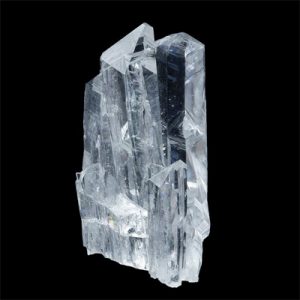Nifontovite
Nifontovite is a very rare Borate mineral that was discovered in 1961 in the Northern Ural Mountains of Russia. Gems are extremely rare. The chemical formula of Nifontovite is Ca3B6O6(OH)12·2(H2O) (Hydrated Calcium Borate Hydroxide) and its molecular weight is 521.21 gm. Until a recent find in Mexico, Nifontovite was rarely found in the Fuka mine, Okayama Prefecture on Honshu Island, Japan as opaque, lamellar aggregate material. The hardness is 3.5 – 5.0 and the specific gravity 2.74 – 2.95 (g/cm3). The crystals recently found in Charcas, San Luis Potosí, Mexico are stunning, perfectly transparent, vitreous (glassy) gem crystals that are colorless and have a perfect termination.
Nifontovite is found in only three localities in the world: the Type Locality at Novofrolovskoye copper deposit, near Krasnoturinsk, Turinsk district, Northern Ural Mountains, Russia; Fuka mine, Bitchu-cho, Takahashi, Okayama Prefecture, Chugoku Region, Honshu Island, Japan; and relatively large, transparent crystals from Charcas, Mun. de Charcas, San Luis Potosí, Mexico.
| Chemical Formula: | Ca3B6O6(OH)12·2(H2O) |
| Hydrated Calcium Borate Hydroxide | |
| Molecular Weight: | 521.21 gm |
| Composition: | Calcium | 23.07 % | Ca | 32.28 % | CaO |
| Boron | 12.44 % | B | 40.07 % | B2O3 | |
| Hydrogen | 3.09 % | H | 27.65 % | H2O | |
| Oxygen | 61.39 % | O | |||
| 100.00 % | 100.00 % | = TOTAL OXIDE |
| Crystallography: | Monoclinic |
| Crystal Habit: | Tabular crystals, to 6 cm; granular. |
| Twinning: | None |
| Cleavage: | Poor/Indistinct |
| Fracture: | Irregular/Uneven |
| Tenacity: | Brittle |
| Moh’s Hardness: | 3.5 – 5.0 |
| Density: | 2.74 – 2.95 (g/cm3) |
| Luminescence: | Fluoresces violet under LW UV. |
| Radioactivity: | Not Radioactive |
| Color: | Colorless to Gray; Colorless in thin section. |
| Transparency: | Transparent to Semi-Transparent |
| Luster: | Vitreous |
| Refractive Index: | 1.575 – 1.584 Biaxial ( + ); showing anomalous interference colors |
| Birefringence: | 0.009 |
| Dispersion: | Weak to Strong; r > v |
| Pleochroism: | None |


